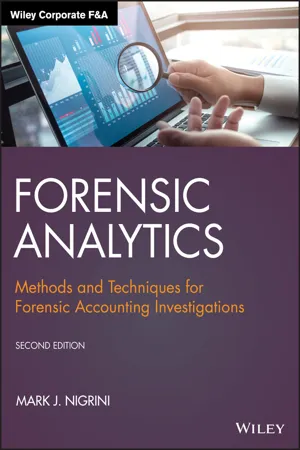
Forensic Analytics
Methods and Techniques for Forensic Accounting Investigations
- English
- ePUB (mobile friendly)
- Available on iOS & Android
About this book
Become the forensic analytics expert in your organization using effective and efficient data analysis tests to find anomalies, biases, and potential fraud—the updated new edition
Forensic Analytics reviews the methods and techniques that forensic accountants can use to detect intentional and unintentional errors, fraud, and biases. This updated second edition shows accountants and auditors how analyzing their corporate or public sector data can highlight transactions, balances, or subsets of transactions or balances in need of attention. These tests are made up of a set of initial high-level overview tests followed by a series of more focused tests. These focused tests use a variety of quantitative methods including Benford's Law, outlier detection, the detection of duplicates, a comparison to benchmarks, time-series methods, risk-scoring, and sometimes simply statistical logic. The tests in the new edition include the newly developed vector variation score that quantifies the change in an array of data from one period to the next. The goals of the tests are to either produce a small sample of suspicious transactions, a small set of transaction groups, or a risk score related to individual transactions or a group of items.
The new edition includes over two hundred figures. Each chapter, where applicable, includes one or more cases showing how the tests under discussion could have detected the fraud or anomalies. The new edition also includes two chapters each describing multi-million-dollar fraud schemes and the insights that can be learned from those examples. These interesting real-world examples help to make the text accessible and understandable for accounting professionals and accounting students without rigorous backgrounds in mathematics and statistics. Emphasizing practical applications, the new edition shows how to use either Excel or Access to run these analytics tests. The book also has some coverage on using Minitab, IDEA, R, and Tableau to run forensic-focused tests. The use of SAS and Power BI rounds out the software coverage. The software screenshots use the latest versions of the software available at the time of writing. This authoritative book:
- Describes the use of statistically-based techniques including Benford's Law, descriptive statistics, and the vector variation score to detect errors and anomalies
- Shows how to run most of the tests in Access and Excel, and other data analysis software packages for a small sample of the tests
- Applies the tests under review in each chapter to the same purchasing card data from a government entity
- Includes interesting cases studies throughout that are linked to the tests being reviewed.
- Includes two comprehensive case studies where data analytics could have detected the frauds before they reached multi-million-dollar levels
- Includes a continually-updated companion website with the data sets used in the chapters, the queries used in the chapters, extra coverage of some topics or cases, end of chapter questions, and end of chapter cases.
Written by a prominent educator and researcher in forensic accounting and auditing, the new edition of Forensic Analytics: Methods and Techniques for Forensic Accounting Investigations is an essential resource for forensic accountants, auditors, comptrollers, fraud investigators, and graduate students.
Frequently asked questions
- Essential is ideal for learners and professionals who enjoy exploring a wide range of subjects. Access the Essential Library with 800,000+ trusted titles and best-sellers across business, personal growth, and the humanities. Includes unlimited reading time and Standard Read Aloud voice.
- Complete: Perfect for advanced learners and researchers needing full, unrestricted access. Unlock 1.4M+ books across hundreds of subjects, including academic and specialized titles. The Complete Plan also includes advanced features like Premium Read Aloud and Research Assistant.
Please note we cannot support devices running on iOS 13 and Android 7 or earlier. Learn more about using the app.
Information
Table of contents
- Cover
- Table of Contents
- List of Cases
- About the Author
- Preface
- Abbreviations
- Analytics Software Used
- Introduction
- CHAPTER 1: Using Microsoft Excel for Forensic Analytics
- CHAPTER 2: The Initial High-Level Overview Tests
- CHAPTER 3: Benford's Law: The Basic Tests
- CHAPTER 4: Benford's Law: Advanced Topics
- CHAPTER 5: Benford's Law: Completing the Cycle
- CHAPTER 6: Identifying Anomalous Outliers: Part 1
- CHAPTER 7: Identifying Anomalous Outliers: Part 2
- CHAPTER 8: Identifying Abnormal Duplications
- CHAPTER 9: Comparing Current Period and Prior Period Data: Part 1
- CHAPTER 10: Comparing Current Period and Prior Period Data : Part 2
- CHAPTER 11: Identifying Anomalies In Time-Series Data
- CHAPTER 12: Scoring Forensic Units for Fraud Risk
- CHAPTER 13: Case Study : An Employee's Fraudulent Tax Refunds
- CHAPTER 14: Case Study : A Supplier's Fraudulent Shipping Claims
- CHAPTER 15: Detecting Financial Statement Fraud
- CHAPTER 16: Using Microsoft Access and R For Analytics
- CHAPTER 17: Concluding Notes on Fraud Prevention and Detection
- Bibliography
- Index
- End User License Agreement